Jupiter’s Moons and Rings
Jupiter hosts at least 67 moons. The four largest—Io, Europa, Ganymede, and Callisto—may have formed at the same time as Jupiter from debris orbiting the planet, just as the planets formed from debris orbiting the Sun (see Chapter 5). Jupiter’s other moons are probably captured planetesimals and smaller pieces of space debris.
Margin Question 8-2
Question
Why did the comet impacts of 1994 not create craters on Jupiter?
Galileo was the first person to observe the four largest moons, in 1610, seen through his meager telescope as pinpoints of light. He called them the Medicean stars to attract the attention of the Medicis, rulers of Florence and wealthy patrons of the arts and sciences. To Galileo, the moons provided evidence supporting the then-controversial Copernican cosmology; at that time, Western theologians asserted that all cosmic bodies orbited Earth. The fact that the Medicean stars orbited Jupiter raised grave concerns in some circles.
 To the modern astronomer, these moons are four extraordinary worlds, different both from the rocky terrestrial planets and from hydrogen-rich Jupiter. Now called collectively the Galilean moons or Galilean satellites, they are named after the mythical lovers and companions of the Greek god Zeus (called Jupiter by the Romans). From the innermost moon outward, they are Io, Europa, Ganymede, and Callisto.
To the modern astronomer, these moons are four extraordinary worlds, different both from the rocky terrestrial planets and from hydrogen-rich Jupiter. Now called collectively the Galilean moons or Galilean satellites, they are named after the mythical lovers and companions of the Greek god Zeus (called Jupiter by the Romans). From the innermost moon outward, they are Io, Europa, Ganymede, and Callisto.
240
These four worlds were photographed extensively by the Voyager 1, Voyager 2, and Cassini flybys and by the Galileo spacecraft that orbited Jupiter (Figure 8-11). The two inner Galilean satellites, Io and Europa, are about the same size as our Moon. The two outer satellites, Ganymede and Callisto, are roughly the size of Mercury. Figure 8-11 presents comparative information about these six bodies.
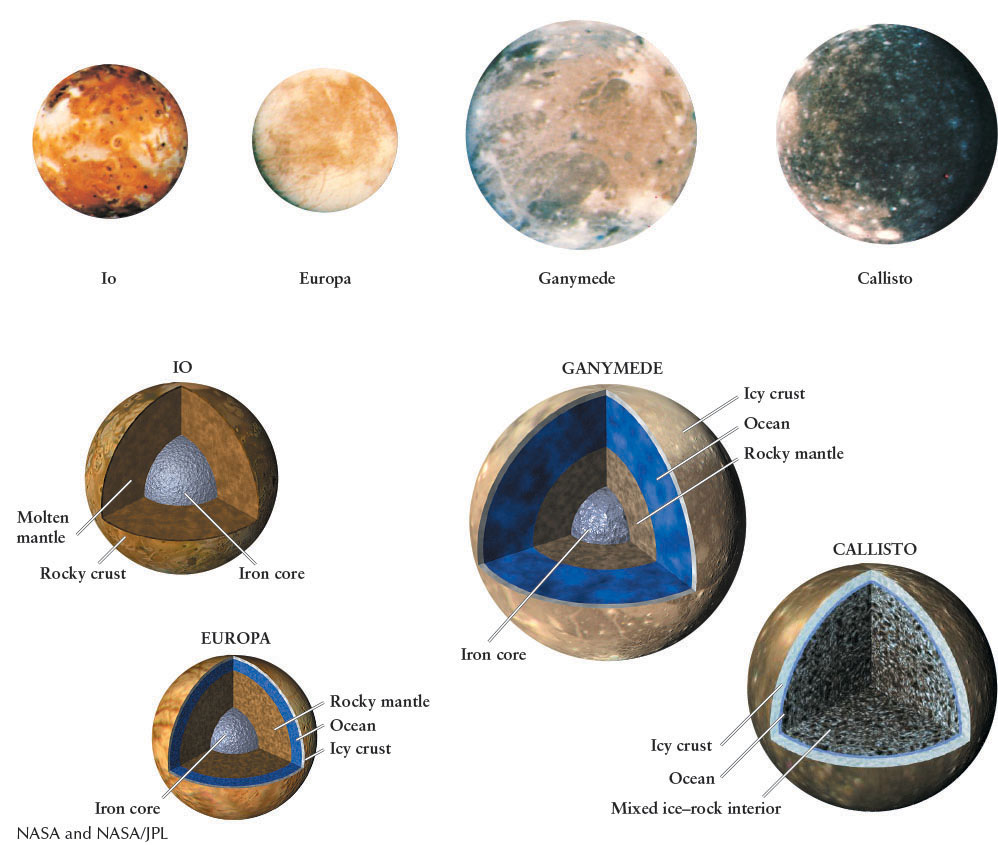
8-4 Io’s surface is sculpted by volcanic activity
Sulfurous Io is among the most exotic moons in our solar system (Figure 8-12a). At first glance, this moon’s density of 3570 kg/m3 seems to place its chemical composition between that of the terrestrial and Jovian planets. However, its density has that value in large measure because its mass is so small that it cannot compress its interior nearly as much as can Earth or more massive planets. Allowing for its lower compression, astronomers calculate that Io is mostly rock and iron, like Earth, rather than being composed of lighter elements, as is Jupiter.
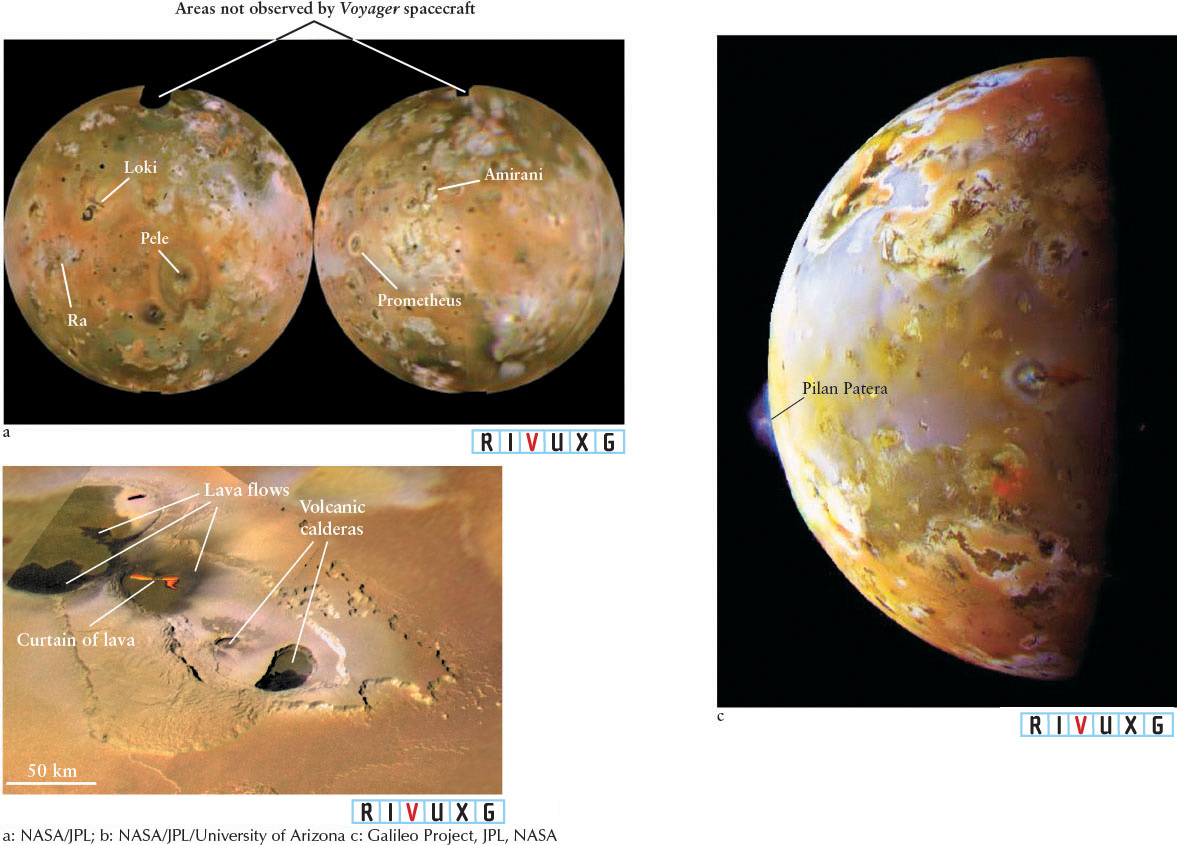
 Io (a) These Voyager images show both sides of Io. The range of colors results from surface deposits of sulfur ejected from Io’s numerous volcanoes. Plumes from the volcano Prometheus rise up 100 km. Prometheus has been active in every image taken of Io since the Voyager flybys of 1979. (b) Photographed in 1999 and then 2000 (shown here), the ongoing lava flow from this volcanic eruption at Tvashtar Patera has considerably altered this region of Io’s surface. (c) Galileo image of an eruption of Pilan Patera on Io.
Io (a) These Voyager images show both sides of Io. The range of colors results from surface deposits of sulfur ejected from Io’s numerous volcanoes. Plumes from the volcano Prometheus rise up 100 km. Prometheus has been active in every image taken of Io since the Voyager flybys of 1979. (b) Photographed in 1999 and then 2000 (shown here), the ongoing lava flow from this volcanic eruption at Tvashtar Patera has considerably altered this region of Io’s surface. (c) Galileo image of an eruption of Pilan Patera on Io.
Io zooms through its orbit of Jupiter once every 1.8 days. Like our Moon, it is in synchronous rotation with its planet. Images of Io reveal giant plumes emitted by about 400 active volcanoes (Figure 8-12c) and lava geysers (analogous to the water geyser Old Faithful on Earth). Most of this ejected material falls back onto Io’s surface; the rest is moving fast enough to escape into space. Besides the violent ejections of lava, Io also has volcanoes out of which lava just pours, rather than spurts. Observations indicate that Io’s volcanoes emit 10 trillion tons of lava each year in plumes up to 500 km high. This is 100 times as much lava as is emitted by all of Earth’s volcanoes. That amount of material is enough to resurface Io to a depth of 1 m each century (Figure 8-12b). One eruption in 2002 occurred over an area the size of London, some 1600 sq km (620 sq mi). The volcanoes emit basaltic lava flows rich in magnesium and iron. Io’s volcanoes are named after gods and goddesses associated with fire in Greek, Norse, Hawaiian, and other mythologies. Io also has numerous black “dots” on its surface, which, apparently, are dormant volcanic vents. Old lava flows radiate from many of these locations, which are typically 10 to 50 km in diameter and cover 5% of Io’s surface.
241
242
What’s in a Name
Following up on the preconceptions that common words create (see Insight Into Science: Imagine the Moon in Chapter 7), objects with familiar names often have different characteristics than we expect. We tend to envision “moons” as spherical, inert, airless, lifeless, dry places similar to our Moon. However, as we will see throughout this chapter, starting with Io, some moons have active volcanoes, atmospheres, and vast underground liquid water oceans. We will also see that most moons are anything but spherical.
Margin Question 8-3
Question
What creates most of the heat inside Io that causes it to have volcanoes and geysers?
Just before their discovery, the existence of active volcanoes on Io was predicted from analysis of the gravitational forces to which that moon is subjected. As it rapidly orbits Jupiter, Io repeatedly passes between Jupiter and one or another of the remaining Galilean satellites. These moons pull on Io, causing it to slightly change its distance from Jupiter. This change in distance creates a change in the tidal forces (see Section 6-8) acting on it from the planet. As the distance between Io and Jupiter varies, the resulting tidal stresses alternately squeeze and flex the moon. This ongoing motion of Io’s interior generates heat through friction, creating as much energy inside Io as the detonation of 2400 tons of TNT every second. As a result, Io has a layer of magma (molten underground material that becomes lava on the surface) some 30–50 km (20–30 mi) below the surface. Gas and magma from it eventually make their way to the moon’s surface, where they are ejected through volcanoes and other vents.
Satellite instruments have identified sulfur and sulfur dioxide in the material erupting from Io’s volcanoes. Sulfur is normally bright yellow. If heated and suddenly cooled, however, it forms molecules that assume a range of colors, from orange and red to black, which accounts for Io’s tremendous range of colors (see Figure 8-12). Sulfur dioxide (SO2) is an acrid gas commonly discharged from volcanic vents here on Earth and, apparently, on Venus. When eruptions on Io release this gas into the cold vacuum of space, the gas crystallizes into white flakes, which fall onto the surface and account for the moon’s whitish deposits.
The Galileo spacecraft detected an atmosphere around Io. Composed of oxygen, sulfur, and sulfur dioxide, it is only one-billionth as dense as the air we breathe. Io’s atmosphere can sometimes be seen to glow blue, red, or green, depending on the gases involved. Gases ejected from Io’s volcanoes have also been observed extending out into space and forming a doughnut-shaped region around Jupiter called the Io torus, about which we will say more shortly.
Io Were in a More Elliptical Orbit
Io is in an exceedingly circular orbit, with an orbital eccentricity (defined in Section 2-5) of e = 0.0041. If Io’s orbital eccentricity were the same as that of our Moon (e = 0.055), it would be even more dynamic than it is today. Currently, more than 95% of Io’s surface is solid, with the remaining surface either active volcanoes or molten lava. With a more eccentric orbit, the moon would change shape significantly more than it does today, leading to much greater internal stresses, friction, and heating. Io would experience so much more volcanic activity and lava flow that perhaps half of its surface would be molten or otherwise active at any moment. Io would also be ejecting more lava into space and hence, after billions of years, it would be a much smaller moon.
8-5 Europa harbors liquid water below its surface
Images of Europa’s ice and rock surface from Voyager 2 and the Galileo spacecraft reveal that the interior of Jupiter’s second-closest Galilean moon contains liquid water (Figure 8-13). Europa orbits Jupiter every 3½ days and, like Io, is in synchronous rotation. The changing gravitational tug of Io creates stress inside Europa similar to the magma-generating distortion that Io undergoes. These stresses apparently cause numerous cracks or fractures seen on Europa’s surface (Figure 8-14a). Furthermore, astronomers think this stress creates the heat inside Europa that is keeping water in a liquid state just a few kilometers below the moon’s ice and rock surface.
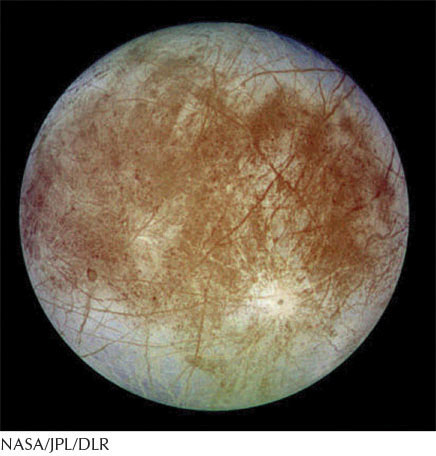
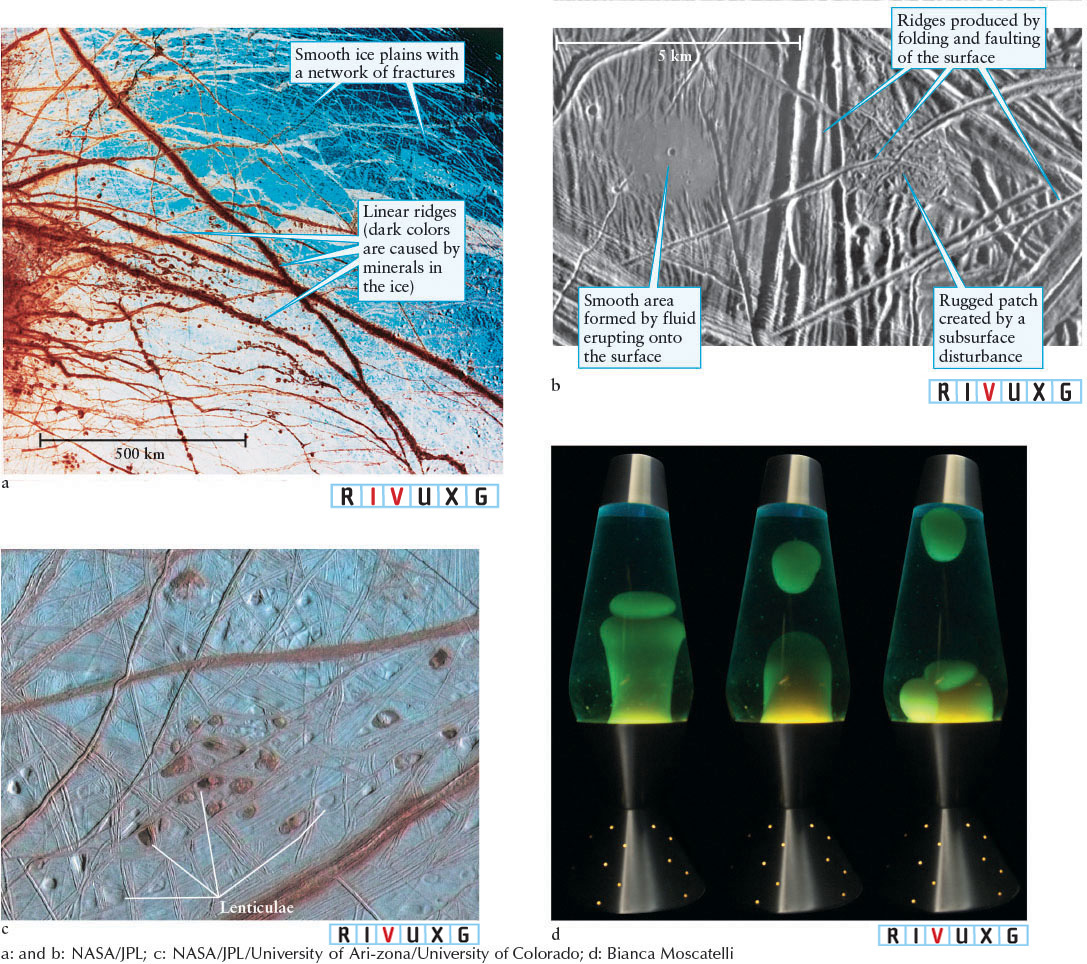
243
Margin Question 8-4
Question
What region on Earth does the surface of Europa most resemble?
Besides the cracks, numerous other features on Europa support the idea that it has liquid water inside. Just as in the Arctic region on Earth, the movement of surface features on Europa creates ice floes, along with swirls, strips, and ridges, driven by circulating water underneath the moon’s surface (Figure 8-14b). Also indicative of liquid water is the moon’s reddish color. The coloring may be due to salt deposits left after liquid water rose to the surface and evaporated (Figures 8-14a, c). Galileo spacecraft images suggest that some of Europa’s features have moved within the past few million years, and perhaps are still in motion. Indeed, the chaotic surface revealed by Galileo is interpreted as having formed as a result of water volcanism on Europa, strengthening the belief that this moon still has a liquid water layer. Replenishment of the surface by tectonic plate motion would explain why only a few small impact craters have survived.
244
Galileo also photographed red and white domes called lenticulae on Europa (Figure 8-14c) that geologists think are rising warmed ice mixed with other material, possibly including organic matter. These lenticulae are typically 100 m high and 10 km (6 mi) wide. The rising material behaves like the blobs in lava lamps (Figure 8-14d), although the lenticulae are calculated to take 100,000 years to reach the surface from the liquid ocean that is believed to exist inside the moon.
Europa’s average density of 2970 kg/m3 is slightly less than Io’s. A quarter of its mass may be water. Europa also has a metallic core of much higher density and a weak magnetic field. In 1995, astronomers discovered an extremely thin atmosphere containing molecular oxygen surrounding Europa. This gas is about 10−11 times as dense as the air we breathe. The oxygen may come from water molecules on the moon’s surface that were broken up by ultraviolet radiation from the Sun.
The underground ocean of Europa is especially interesting to scientists because virtually all liquid water locations on Earth support life, and life may well have evolved in Europa’s oceans. If it exists, and if it evolved differently from life on Earth, then life-forms from Earth would likely contaminate it, potentially wiping it out. This process would be analogous to the deadly impact of diseases on Earth, such as the introduction of small-pox to the Americas from Europe. To prevent the expired spacecraft Galileo from contaminating any life that may exist on Europa, NASA sent that spacecraft into Jupiter’s thick atmosphere, where the machine was vaporized.
8-6 Ganymede is larger than Mercury
Ganymede is the largest satellite in the solar system (Figure 8-15). Its diameter is greater than Mercury’s, but its density of 1940 kg/m3 is much less than that of Mercury. This moon also has a permanent magnetic field that is twice as strong as Mercury’s field. Ganymede orbits Jupiter in synchronous rotation once every 7.2 days. Like its neighbor Europa, Ganymede has an iron-rich core, a rocky mantle, an underground liquid water ocean, a thin atmosphere, and a covering of dirty ice.
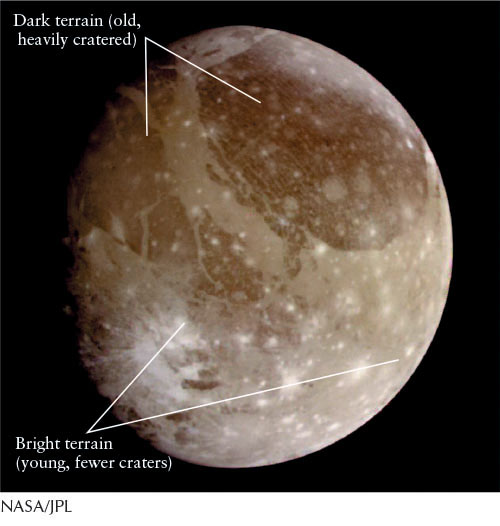
Margin Question 8-5
Question
Which planet is smaller than Ganymede?
The existence of an underground ocean is implied by the discovery of a second magnetic field around Ganymede, which continually varies. This field has a different origin than the permanent one just mentioned; the second field is generated by Jupiter’s magnetic field. As Ganymede orbits Jupiter, the planet’s powerful magnetic field creates an electric current inside the moon, which, in turn, creates Ganymede’s varying magnetic field. The field varies as the moon rotates and as it revolves around Jupiter. The best explanation of why current flows inside Ganymede is that liquid saltwater exists there, and saltwater is a good conductor of electricity. This implies, of course, the presence of a liquid ocean. Furthermore, salts have been observed on Ganymede’s surface. They were apparently carried upward and deposited there as water leaked out and froze. As on Europa, liquid water may imply the presence of life.
Like our Moon, Ganymede has two very different kinds of terrain (Figure 8-15 and Figure 8-16). Dark, polygon-shaped regions are its oldest surface features, as judged by their numerous craters. Light-colored, heavily grooved terrain is found between the dark, angular islands. These lighter regions are much less cratered and therefore younger. Ganymede’s grooved terrain consists of parallel mountain ridges up to 1 km high and spaced 10 to 15 km apart. These features suggest that the process of plate tectonics may have dominated Ganymede’s early history. But, unlike Europa, where tectonic activity still occurs today, tectonics on Ganymede ceased 3 billion years ago as the satellite’s crust froze solid.

245
Another mechanism that is likely to have helped create Ganymede’s large-scale features originated in a bizarre property of water. Unlike most liquids, which shrink upon solidifying, water expands when it freezes. Seeping up through cracks in Ganymede’s original crust and solidifying, water may have forced apart fragments of that crust. This process could have produced jagged, dark islands of old crust separated by bands of younger, light-colored, heavily grooved ice.
Ganymede has a thin atmosphere known to contain oxygen, and possibly other gases. As that moon passes through Jupiter’s magnetic field, that oxygen is bombarded by electrons trapped by the field. These collisions cause the gas in Ganymede’s atmosphere to give off radiation, creating auroras, which were first observed in 1998.
8-7 Callisto bears the scars of a huge asteroid impact
Callisto is Jupiter’s outermost Galilean moon. It orbits Jupiter in 16.7 days, and, like the other Galilean moons, its rotation is synchronous. Callisto is 91% as big and 96% as dense as Ganymede, and has a thin atmosphere of hydrogen and carbon dioxide. Like Ganymede, Callisto apparently harbors a substantial liquid water ocean. As with Ganymede, this ocean’s presence is inferred by Callisto’s changing magnetic field. The heat that keeps the ocean liquid likely comes from energy released by radioactive decay inside the moon.
Although numerous large impact craters are scattered over Callisto’s dark, ancient, icy crust, it has very few craters smaller than 100 m across (Figure 8-17). Astronomers speculate that the smaller craters have disintegrated. Unlike Ganymede and Europa, Callisto has no younger, grooved terrain. The absence of grooved terrain suggests that tectonic activity never began there, probably because the satellite simply froze too rapidly. It is bitterly cold on Callisto’s surface. Voyager instruments measured a noontime temperature of 155 K (−180°F), and the nighttime temperature plunges to 80 K (−315°F).

Margin Question 8-6
Question
What features on our Moon and on Mercury are similar to Callisto’s Valhalla impact basin?
Like Mercury, our Moon, and other bodies we will encounter shortly, Callisto carries the cold, hard evidence of what happens when one astronomical body strikes another. Voyager 1 photographed a huge impact basin named Valhalla on Callisto (see Figure 8-17a). An asteroid-sized object produced Valhalla Basin, which is located on Callisto’s Jupiter-facing hemisphere. Like throwing a rock into a calm lake, ripples ran out from the impact site along Callisto’s surface, cracking the surface and freezing into place. The largest remnant rings surrounding the impact crater have diameters of 3000 km. In 2001, the Galileo spacecraft revealed spires 80–100 m high on Callisto (Figure 8-17b). These spires are also believed to have been created by an impact, perhaps the same one. One feature that is missing from Callisto is the jumbled terrain on the side opposite of Valhalla Basin, as is seen opposite of large impact sites on Mercury and our Moon. The smoothness of Callisto can be explained by a model that shows that a liquid water interior would dampen the impact shock and thereby prevent the opposite side from becoming disturbed. This theory supports the idea that Callisto has liquid water inside. The probable interiors of the Galilean moons are shown in Figure 8-11.
246
8-8 Other debris orbits Jupiter as smaller moons and ringlets
Besides the four Galilean moons, Jupiter has at least 63 other moons, a set of tenuous ringlets, and two doughnut-shaped tori of electrically charged gas particles. The non-Galilean moons are all irregular in shape and less than 275 km in diameter. Four of these moons (Figure 8-18) are inside Io’s orbit; all of the other known moons are outside Callisto’s orbit. The inner moon Amalthea (see Figure 8-18) is red-colored, has about the same density as water, and is apparently made of pieces of rock and ice barely held together by the moon’s own gravity. The Galilean moons, along with the smaller moons closer to Jupiter and six of the outer moons, orbit in the same direction that Jupiter rotates (prograde orbits). The remaining outer moons revolve in the opposite direction (retrograde orbits). The outer ones appear to be individual captured planetesimals, while the inner ones are probably smaller pieces broken off a single larger body.

Margin Question 8-7
Question
What other objects that we have already studied in the solar system are similar to the smaller moons of Jupiter?
 Jupiter is only the first of four planets with rings. Its ring system is composed of several parts (Figure 8-19a). Debris knocked off the moons Adrastea and Metis is responsible for the main ring. The outer edge of this ring has three well-defined ringlets (Figure 8-19b) that are pieces of debris ranging in size from gravel to small boulders. The rest of the ring, extending about 10,000 km inward toward Jupiter, is composed of dust-sized particles. This ring is less than 50 km (30 mi) thick, which is exceptionally thin compared to its width. Apparently some of the smallest particles leak inward, creating the halo ring (see Figure 8-19a).
Jupiter is only the first of four planets with rings. Its ring system is composed of several parts (Figure 8-19a). Debris knocked off the moons Adrastea and Metis is responsible for the main ring. The outer edge of this ring has three well-defined ringlets (Figure 8-19b) that are pieces of debris ranging in size from gravel to small boulders. The rest of the ring, extending about 10,000 km inward toward Jupiter, is composed of dust-sized particles. This ring is less than 50 km (30 mi) thick, which is exceptionally thin compared to its width. Apparently some of the smallest particles leak inward, creating the halo ring (see Figure 8-19a).

247
Debris ejected from the moons Amalthea and The be creates thicker rings of very tiny dust particles called the gossamer rings. While some of the ring material is continually being ejected by collisions between particles and by radiation from the Sun, impacts freeing regolith from the moons are continually replenishing all the rings.
At least two doughnut-shaped regions (or tori) of electrically charged gas particles, called plasmas, orbit Jupiter. One is in the same orbit as Io (Figure 8-19c). The Io torus consists of sulfur and oxygen ions (charged atoms) along with free electrons. These particles were ejected by Io’s geysers, and they are held in orbit by Jupiter’s strong magnetic field. Guided by the field, some of this matter spirals in toward Jupiter, thereby creating the aurora seen there (see Figure 8-9b). It may also contribute to Jupiter’s distinct coloration.
The other torus is in Europa’s orbit (Figure 8-19c), and consists of hydrogen and oxygen ions and electrons created from water molecules kicked off Europa’s surface by radiation from Jupiter. The mass of this ring of gas is calculated to be only about 5.4 × 104 kg (6 × 104 tons).